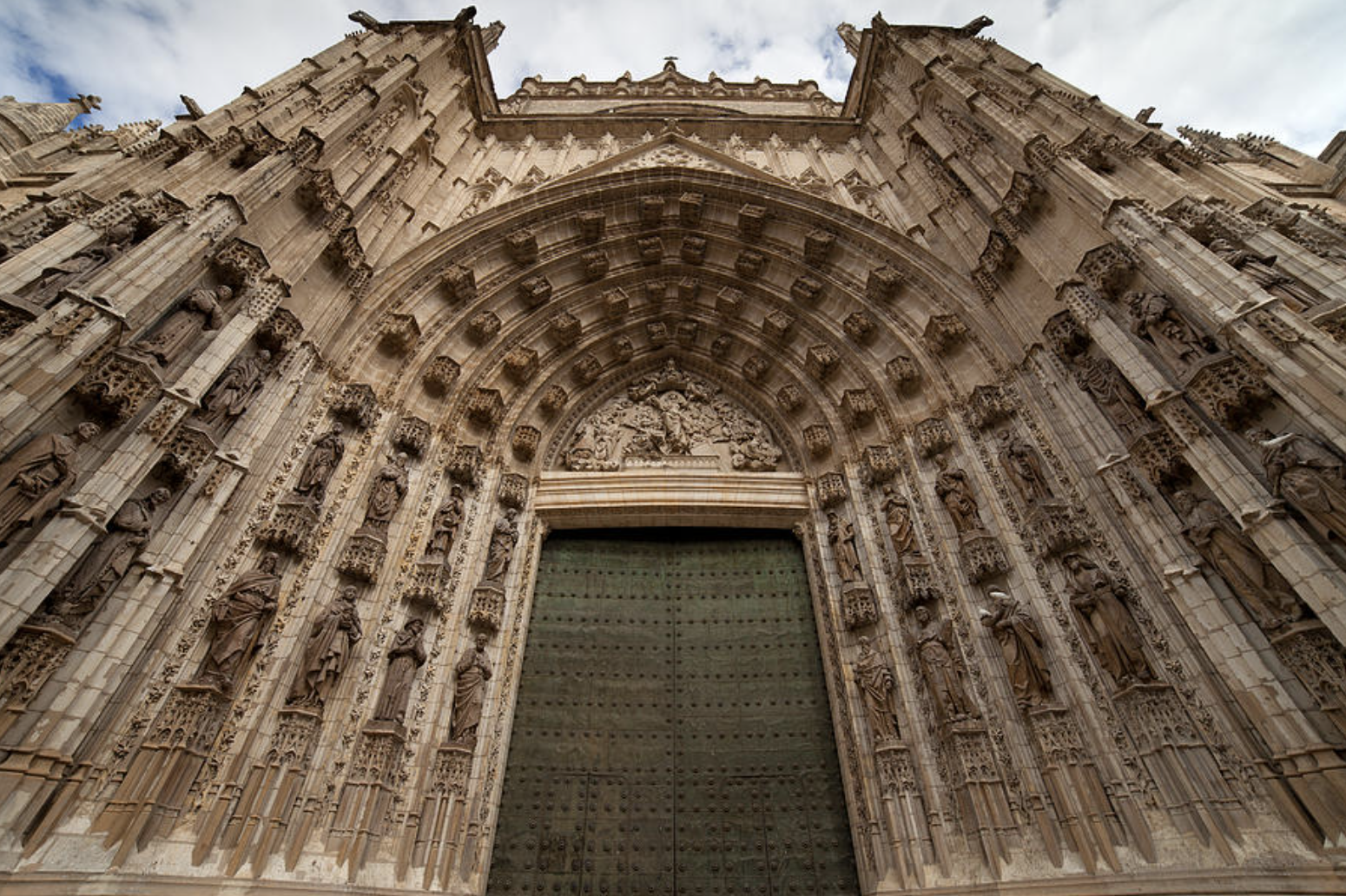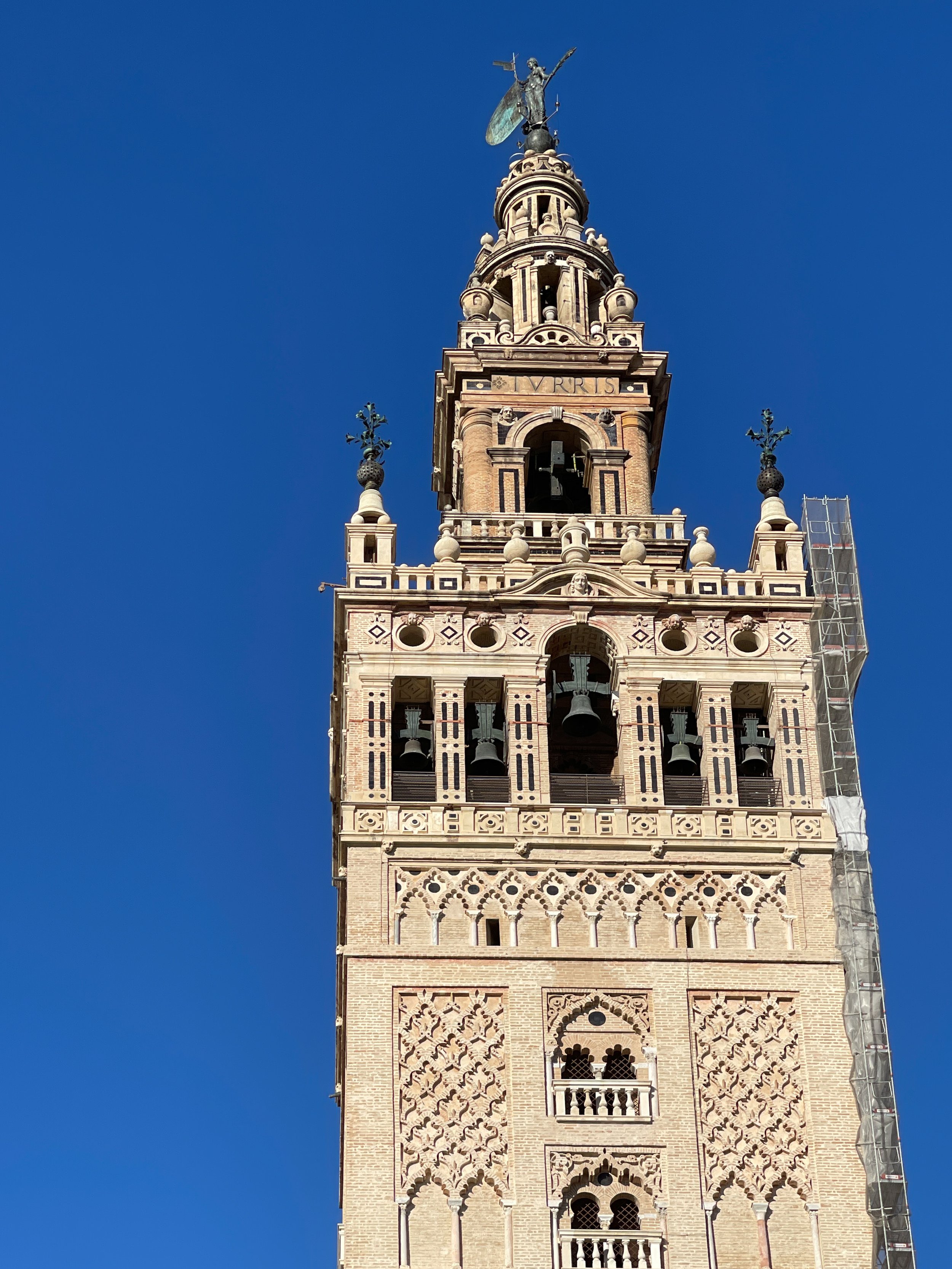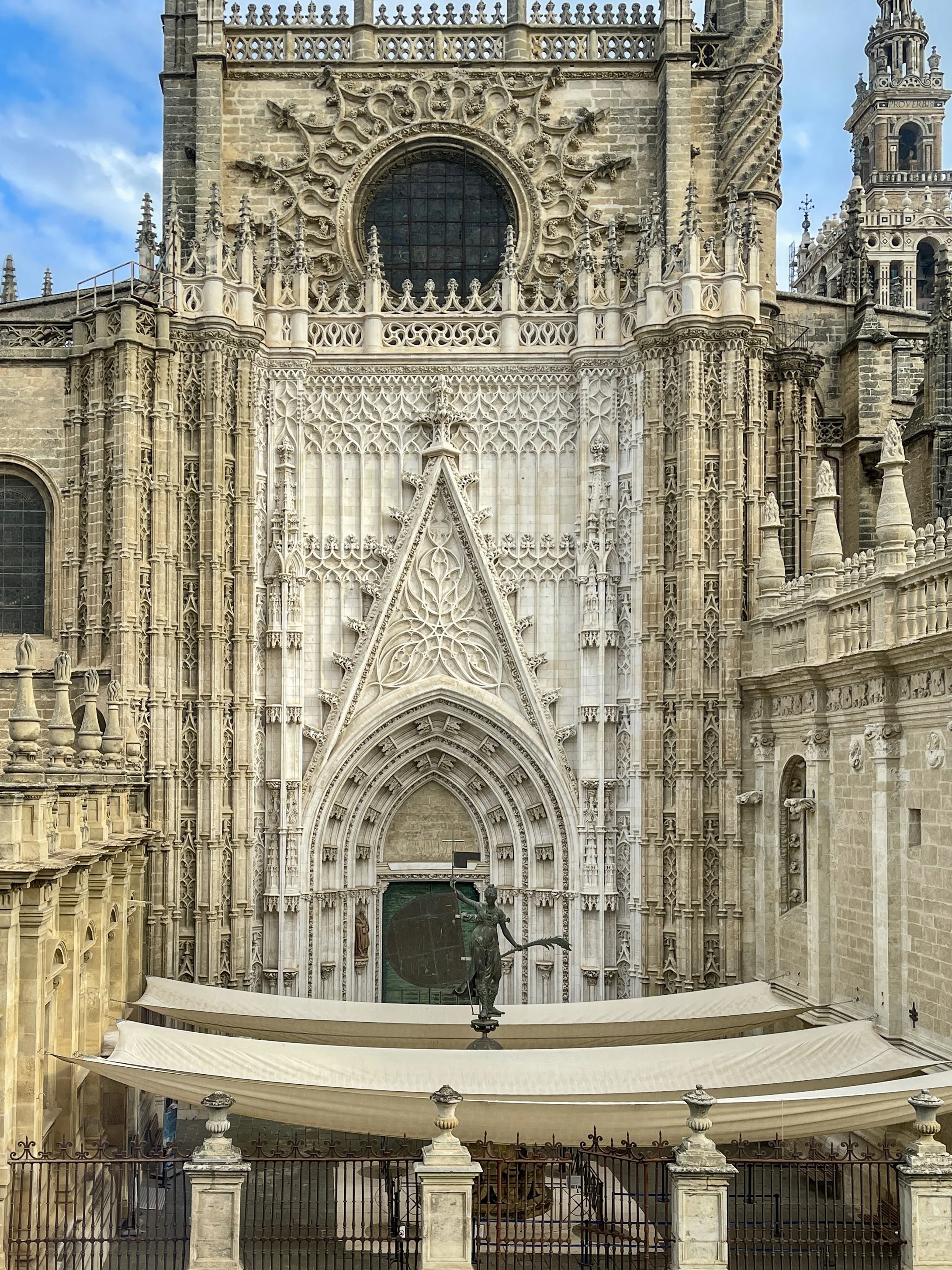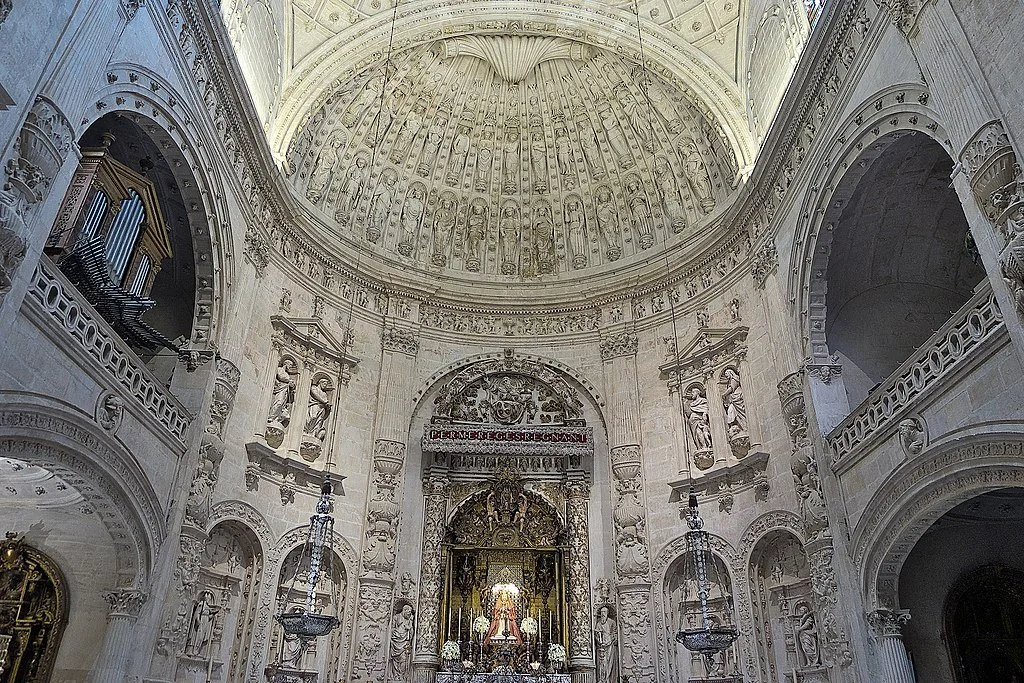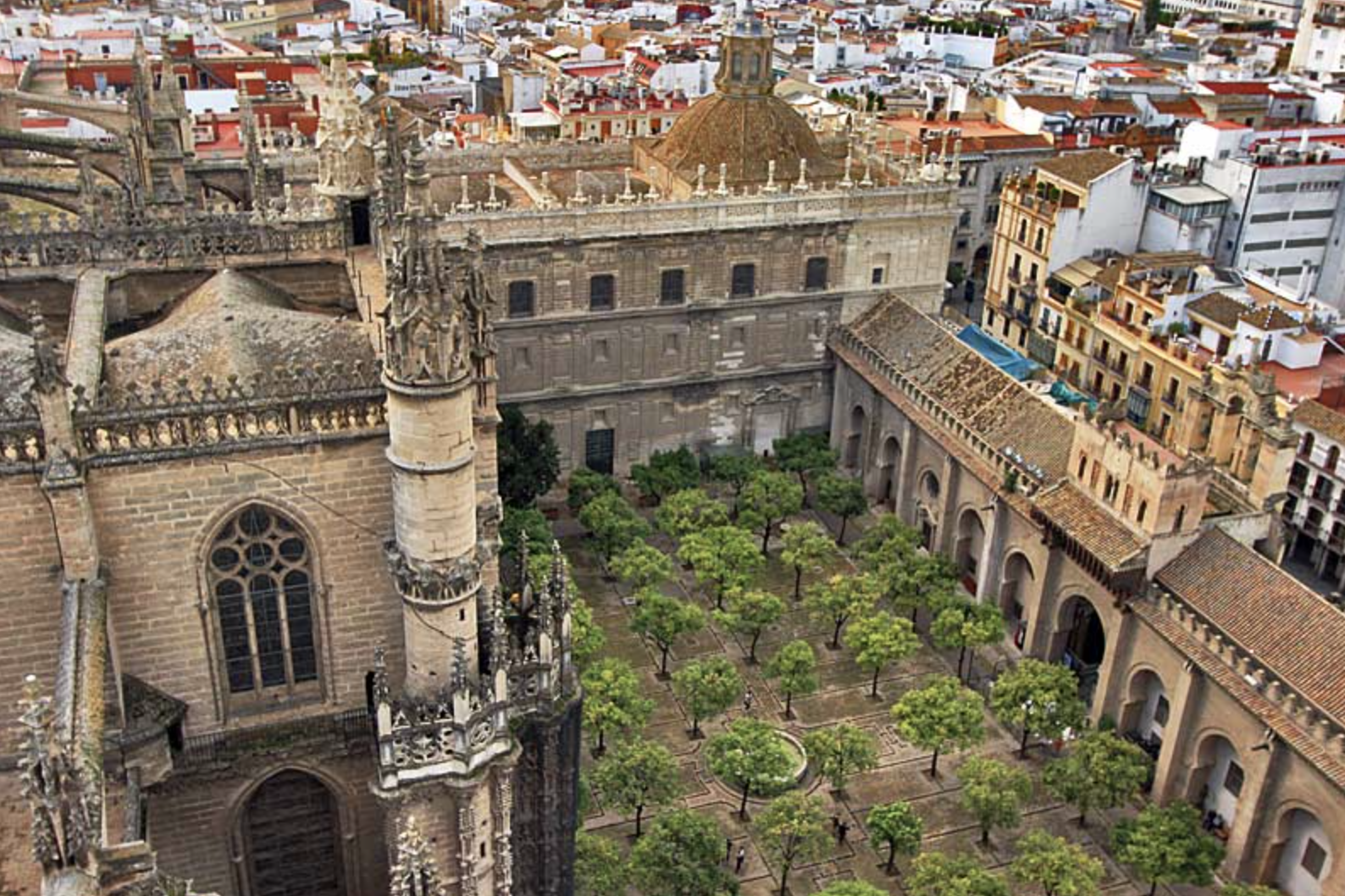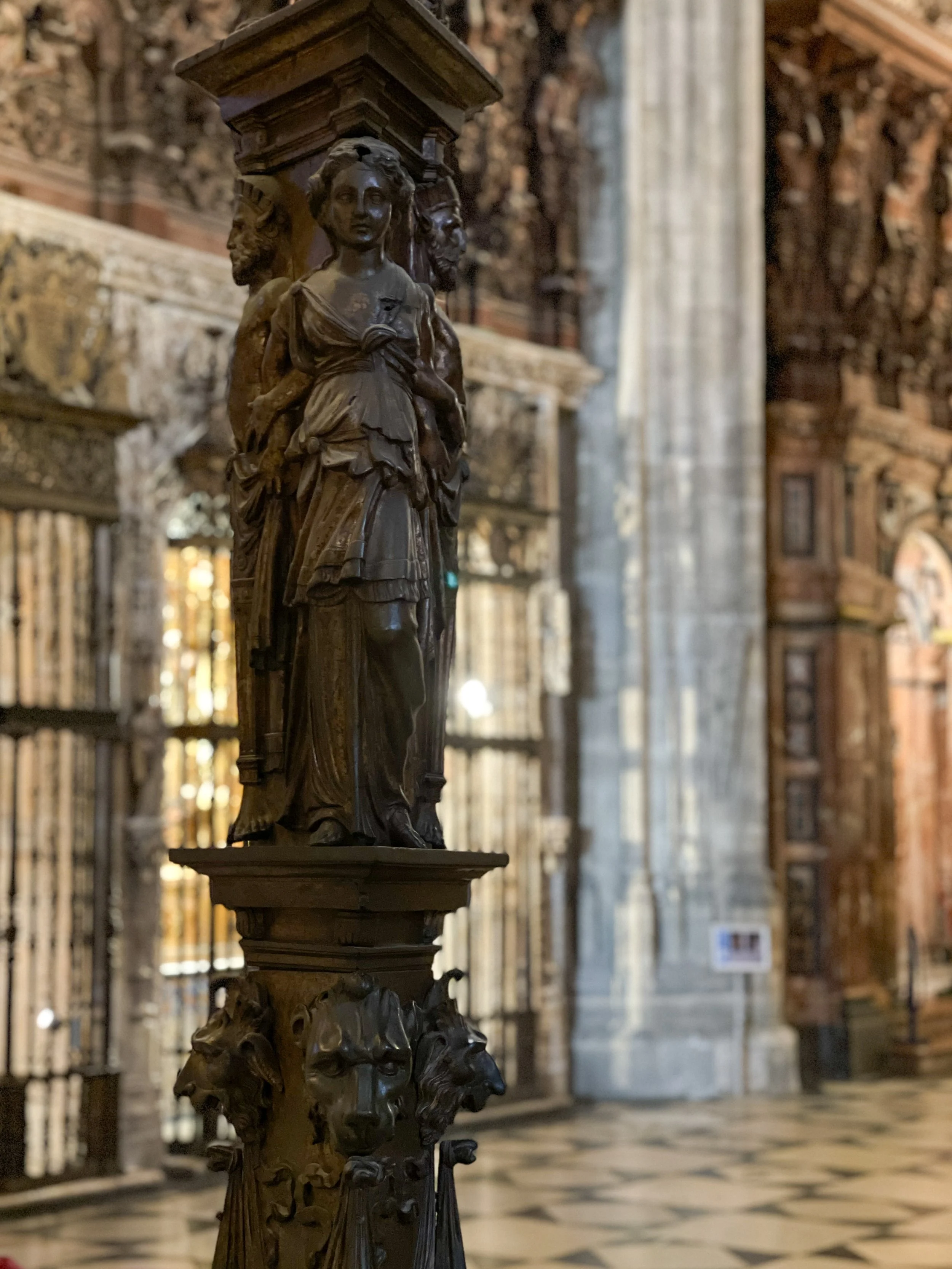Discover the world’s largest Gothic cathedral, a UNESCO World Heritage Site with the iconic La Giralda bell tower and Columbus’ tomb.
The Seville Cathedral dominates the skyline — not surprisingly, since it's the largest Gothic cathedral in the world.
As you walk through the narrow, winding streets of Seville, you’ll inevitably find yourself in the Plaza del Triunfo. There, rising as a colossal monument to faith and human ingenuity, stands La Catedral de Sevilla (Seville Cathedral). It’s hard not to feel a sense of awe as you take in the sight before you — this is the largest Gothic cathedral in the world, and it commands your attention.
Gothic architecture was all about height and light, creating spaces that drew the eyes — and the spirit — upward. The architects of Seville Cathedral embraced this philosophy wholeheartedly. They designed a building that seemed to defy gravity, with soaring arches, intricate ribbed vaults and walls of stone that appear as delicate as lace.
“The towering high altar of Seville Cathedral seems to glow with an otherworldly light.
It’s the largest and one of the most ornate Catholic altars in the world — a gilded masterpiece that took nearly a century to complete. ”
With its intricate ornamentation, the cathedral is gorgeous from any angle.
Visiting Seville Cathedral: First Impressions
The façade of Seville Cathedral is an intricate pattern of religious figures and mythical beasts, all carved in stone with remarkable detail. Saints and apostles line the entrances, each captured in dynamic poses, holding symbols of their faith and martyrdom. Figures like Saint Peter with his keys to Heaven and Saint James with his staff stand as silent guardians of the cathedral. Above the portals, scenes from the life of Christ and the Virgin Mary are depicted in elaborate reliefs.
Statues of holy personages ring the cathedral's doorways.
Interspersed among these sacred figures are gargoyles — grotesque stone creatures jutting out from the walls. Their twisted forms, often a blend of animals with something monstrous, serve both symbolic and functional roles. They channel rainwater away from the building, but they also act as protectors, believed to ward off evil spirits from entering the holy site.
La Giralda rises 341 feet (104 meters) into the air.
The Symbolism of La Giralda: A Story in Stone
Look closely at the base of the tower, where the original stonework from the Almohad Muslim empire remains intact. The arches, adorned with delicate arabesques, are a reminder of the tower’s Islamic origins. They speak of a time when Seville was a center of learning and culture in the Islamic world, a place where scholars and artisans thrived.
Part Islamic, part Renaissance, La Giralda is a good symbol of the merging of East and West that's such a part of southern Spain.
Now, let your gaze travel upward, to the belfry that was added during the Renaissance. The clean lines, classical proportions and elegant simplicity of the design are a stark contrast to the intricate patterns below. This was a statement, a declaration of the Christian faith’s ascendancy.
Driving home that point is the Latin verse inscribed around the belfry: “TURRIS FORTISSIMA NOMEN DNI PROVERB. 18,” translating to “The name of the Lord is a strong tower,” from Proverbs 18:10.
High above the city, El Giraldillo stands poised on La Giralda, her massive bronze figure more than just a weather vane — she’s a symbol of faith and victory. Cloaked in a flowing tunic, she holds a mighty shield in one hand and a palm branch in the other. Her figure twists gracefully, moved by the winds, but her expression and stance evoke unshakable faith. Like a sentinel or an ancient goddess, she watches over her city.
El Giraldillo: the most famous weathervane in the world?
La Giralda’s Lesser-Known Secrets
La Giralda also holds secrets that many visitors aren’t familiar with. For instance, did you know that the tower was designed with ramps instead of stairs? This allowed the muezzin, who called the faithful to prayer, to ride a horse to the top. As you imagine this, you can almost hear the rhythmic clatter of hooves echoing within the tower’s walls.
Another lesser-known fact is that during the cathedral’s construction, La Giralda served as a lookout tower. From its heights, guards could survey the city and the surrounding countryside, a strategic vantage point that was vital during times of conflict.
Duke got this shot from the nearby General Archive of the Indies. You can see the copy of El Giraldillo that topped the tower while the genuine article got restored.
The Entrance of Seville Cathedral
In front of the cathedral, a statue of Ferdinand III of Castile proudly holds a globe and a sword, commemorating his pivotal role in the 13th century Christian conquest of Seville. Ferdinand’s victory led to the transformation of the city from an Islamic stronghold into a key Christian center, with the mosque being converted into the cathedral we see today.
But Ferdinand isn’t the only figure watching over the entrance. Nearby stands a replica of El Giraldillo. The bronze reproduction topped the tower during a restoration and was moved here when the original figure returned to its rightful place atop La Giralda.
As you step inside the cathedral, your eyes are immediately drawn upward. Massive stone columns rise like ancient trees in a forest, supporting the ceiling. These columns branch out into ribbed vaults, forming a web-like pattern that not only adds to the structure’s stability but also creates an otherworldly sense of space.
The high altar of Seville Cathedral, a breathtaking display of intricate gold niches, showcases scenes from the life of Christ.
The High Altar: A Golden Marvel
The towering structure of the high altar of Seville Cathedral seems to glow with an otherworldly light. It’s the largest and one of the most ornate Catholic altars in the world — a gilded masterpiece that took nearly a century to complete.
Crafted by Flemish sculptor Pierre Dancart in the late 15th century, the altar rises over 65 feet high and 42 feet wide, composed of 45 intricately carved panels — it feels like an epic storybook springing to life, scene by scene, pulling you into its divine narrative. Imagine it as a tapestry of tales, each vignette acting as a page from the most sacred stories in Christian tradition.
The altar's reliefs are intricately carved wood covered in gold leaf.
At the base, you can see the Nativity, with Mary cradling the infant Jesus, the shepherds humbly offering their reverence, and the Magi presenting their gifts.
Move higher, and the story unfolds into more dramatic, intense episodes. In one vignette, you can see the Crucifixion, then comes the Resurrection, bursting forth from the altar’s center, where Christ, victorious over death, stands surrounded by heavenly figures. (Related: When did Jesus Have to Become God?)
The higher tiers focus on the Ascension of Mary, where she rises amid a host of saints and angels, emphasizing her purity and elevation as the Queen of Heaven.
Each story is framed with ornate Gothic tracery, like delicate borders separating the sacred moments yet tying them all together into one continuous narrative, acting like pages of a gilded gospel.
Columbus' tomb
The Tomb of Christopher Columbus: A Monument Shrouded in Mystery
Inside Seville Cathedral, amid its towering arches and breathtaking art, you’ll find something that has captured the imaginations of visitors for centuries: the tomb of Christopher Columbus, known in Spain as Cristóbal Colón. It’s a monument wrapped in mystery and steeped in controversy, honoring one of history’s most famous and contentious figures.
The ornate tomb seems to be held aloft by four statues, each representing one of the kingdoms of Spain: Castile, León, Aragon and Navarre. These larger-than-life figures, clad in armor and bearing the weight of the tomb on their shoulders, carry not just the remains of a man, but the legacy of an era that forever changed the world. Their expressions are solemn, their posture resolute, as if they understand the weight — both literal and symbolic — that they bear.
Is Seville Cathedral really the site of Columbus' corpse?
The Journey of Columbus’ Remains: A Tale of Many Cities
Here’s where the story takes a fascinating turn: Columbus’ remains have journeyed across the world almost as much as he did during his lifetime. After his death in 1506, Columbus was initially buried in Valladolid, Spain, the city where he died. Yet this was only the beginning of his posthumous odyssey.
A few years later, his remains were moved to Seville, then across the Atlantic to the island of Hispaniola (modern-day Dominican Republic) in the early 16th century, as Columbus had expressed a desire to be buried in the so-called New World he helped to “discover.”
But the story doesn’t end there. Before the French took control of Hispaniola in 1795, Columbus’ remains were supposedly transferred to Havana, Cuba, to prevent them from falling into French hands.
Then, in 1898, after Spain lost control of Cuba following the Spanish-American War, the explorer’s remains were sent back to Seville, where they were interred in the cathedral.
The ornate tomb that visitors see today was designed by the Spanish sculptor Arturo Mélida. Made from a mix of materials, including bronze and marble, the tomb features intricate carvings that tell the story of Columbus’ voyages.
The underside of Columbus' tomb
The Controversy: Are These Columbus’ True Remains?
But here’s the twist: Are the remains in Seville Cathedral really those of Christopher Columbus? This question has sparked debate among historians, scientists and enthusiasts for years. The Dominican Republic claims that it still holds the true remains of Columbus in the Columbus Lighthouse in Santo Domingo, and that the bones moved to Havana and later to Seville were actually those of his son, Diego.
In 2003, DNA testing was conducted on the remains in Seville, comparing them to the known DNA of Columbus’ brother, also named Diego, who’s buried in the city. The results were inconclusive but suggested a close familial match. While this supports the claim that Seville holds Columbus’ remains, the mystery remains unsolved — especially since the Dominican Republic has refused to allow the testing of the remains in Santo Domingo.
The Ghost of Columbus and His Troubled Legacy
Some say that Columbus’ spirit roams the cathedral, restless due to the uncertainty surrounding his remains. And it’s said that if you listen closely at night, you might hear the faint sound of waves lapping against a ship’s hull — Columbus’ spirit, still seeking the shores of a New World. It’s just one of the many legends of Seville Cathedral.
While many Spaniards still recognize and honor Columbus for his role in history — particularly for his voyages that led to the European colonization of the Americas — there’s also a growing awareness and acknowledgment of the darker aspects of his legacy, recognizing the consequences of his expeditions, including the forced labor and diseases that devastated indigenous populations.
A few kings of Spain are buried in the Royal Chapel of Seville Cathedral.
The Capilla Real (Royal Chapel): Resting Place of Spanish Royalty
In most Gothic cathedrals, the eastern end is typically home to an apse and an ambulatory, designed to guide the flow of worshippers and pilgrims. But in Seville Cathedral, the eastern end holds something quite different and historically significant: the Capilla Real, or Royal Chapel.
The Capilla Real
This impressive, domed structure houses the tombs of Spanish royalty. Dominating the chapel is the ornate burial site of King Ferdinand III, known as Ferdinand the Saint, whom we met out front — the monarch who played a critical role in the Reconquista by reclaiming Seville from Muslim rule in 1248. His body, said to be miraculously preserved, lies in a silver casket beneath the altar.
The chapel also contains the remains of Alfonso X, his son, a king remembered for his patronage of the arts and legal reforms, leading to his nickname Alfonso the Wise.
Then there’s the tomb of Pedro I, often called Pedro the Cruel (or Pedro the Just by his supporters). Known for his ruthless methods of maintaining power, Pedro I rebuilt much of the nearby Real Alcázar of Seville.
The treasury includes the Crown of the Virgin of the Kings, made in 1904.
The Treasury: Relics and Sacred Artifacts
Beyond the paintings and sculptures, Seville Cathedral houses a vast treasury filled with relics and sacred artifacts. Among the most notable is the Custodia de Arfe, a massive silver monstrance created by Enrique de Arfe in the early 16th century. Standing over 12 feet tall, this masterpiece of metalwork is used during the annual Corpus Christi procession, where it’s paraded through the streets of Seville.
The treasury also contains an array of other priceless items, from jewel-encrusted chalices to intricately carved crosses.
The Vision of Saint Anthony of Padua by Bartolomé Esteban Murillo, 1656. At one point, the saint had been cut out of the painting and smuggled to the U.S.!
Murillo’s Masterpieces: Capturing Divine Grace
Seville Cathedral is home to many works of art, but among the most revered are the paintings of Bartolomé Esteban Murillo, one of Spain’s greatest Baroque artists. Murillo’s work is known for its luminous quality, capturing the divine grace of his subjects with an almost ethereal softness.
In The Vision of Saint Anthony of Padua, the saint gazes upwards, his expression one of pure rapture, as the Christ Child appears before him in a radiant burst of light. Here’s a crazy story: Saint Anthony was cut out of the painting in 1874 and smuggled to the United States, where an immigrant sold it to a New York gallery owner. Thankfully, the man made sure it was returned to the cathedral.
Other works by Murillo in the cathedral include The Immaculate Conception, Saint Isidore of Seville and Saint Leander of Seville.
Saints Justa and Rufina by Francisco de Goya, 1817. The women are the patron saints of Seville.
Zurbarán and Goya: Masters of Light and Shadow
The cathedral’s collection also includes paintings by Francisco de Zurbarán and Francisco de Goya, two other giants of Spanish art. Zurbarán’s work is known for its dramatic use of light and shadow, creating a sense of intense spirituality.
Goya, on the other hand, brings a more psychological depth to his works. His Santa Justa and Santa Rufina, depicting the two patron saints of Seville, is a study in contrasts — between light and shadow, and faith and suffering. The saints’ expressions are both serene and sorrowful, capturing the complex emotions of their martyrdom.
The Patio de los Naranjos was part of the original mosque that stood on this site.
The Patio de los Naranjos
Tucked away within Seville Cathedral lies the Patio de los Naranjos, a courtyard steeped in history and shaded by fragrant orange trees. This serene space is one of the few surviving remnants from the original Almohad mosque that once stood on this site. Built in the late 12th century, the patio was initially used by Muslim worshippers for ablutions, a ritual washing before prayer.
The patio’s arched entranceways and elegant fountains have been preserved, though the orange trees themselves were likely added after the Christian Reconquest.
Seville Cathedral was built on the site of a 12th century Almohad mosque, with some elements retained.
The courtyard’s irrigation system is a holdover from the mosque’s original design. Channels carved into the stone floor direct water to the trees and fountain, showcasing the advanced engineering techniques of the period.
Beyond its architectural significance, the Patio de los Naranjos has also served as a gathering place over the years — first for religious purposes, and later as a civic space where citizens met, traded goods and exchanged news.
La Giralda was undergoing repairs when we visited.
Restoration and Preservation: Protecting a Cultural Treasure
The largest Gothic cathedral in the world: With such a significant title comes great responsibility. Over the years, Seville Cathedral has undergone numerous restoration and preservation efforts aimed at protecting its delicate structures and priceless artworks from the ravages of time. These projects are often painstakingly complex, involving skilled artisans and conservators who work to maintain the integrity of the cathedral’s original design while using modern techniques to ensure its longevity.
One of the most significant recent restoration projects focused on La Giralda. Over centuries, exposure to the elements had taken its toll on the tower’s intricate stonework, leading to erosion and structural weakening. The restoration, completed in the early 2000s, involved carefully cleaning and repairing the stone, reinforcing weakened areas and restoring the tower’s original splendor. Today, La Giralda stands tall, a beacon for all of Seville — and, as mentioned, its temporary replacement can be seen in the entrance courtyard.
Inside the cathedral, restoration work is ongoing as well. The high altar, with its intricate gilded panels, has been the focus of several preservation efforts aimed at protecting it from humidity and pollution.
Similarly, the cathedral’s numerous chapels, paintings and sculptures are regularly monitored and conserved to ensure they remain as vibrant and inspiring as they were when first created.
The Puerta del Perdón (Door of Forgiveness) gets its name from the tradition of granting absolution to debtors and sinners who entered through it.
A Major Tourist Attraction: Drawing the World to Seville
Seville Cathedral is one of the city’s top tourist attractions, drawing millions of visitors each year who come to explore its architectural wonders, artistic treasures and historical significance. The cathedral’s central location makes it an essential stop on any tour of Seville.
Guided tours, often led by knowledgeable local historians, offer visitors a chance to delve deeper into the history of Seville Cathedral and its many hidden stories.
In addition to its historical and religious significance, the cathedral offers one of the best views in Seville. Visitors can climb to the top of the Giralda tower, following the same winding ramps that were once used by horseback riders to ascend to the top.
From there, the panoramic view of Seville is breathtaking, with the city’s rooftops, narrow streets and distant hills stretching out as far as the eye can see. It’s a view that not only showcases the beauty of Seville but also puts the cathedral’s dominance over the cityscape into perspective.
The cathedral interior doesn't instill that immediate awe that so many others do — until you look up.
Is the Seville Cathedral Worth Visiting?
The cathedral’s interior is vast, covering an area of about 124,000 square feet (over 11,500 square meters). However, unlike many other large cathedrals where the central nave and the main altar dominate the space, Seville Cathedral has a somewhat fragmented layout that feels sprawling and compartmentalized. It just doesn’t inspire the immediate awe that other Spanish churches do, like the Iglesia de los Santos Mártires and Iglesia de Santiago Apóstol in Málaga. Maybe I’m just not a huge fan of Gothic interiors — I felt similarly underwhelmed at Notre-Dame in Paris.
Numerous chapels, side altars and smaller spaces break up the vast interior. One reason for this disjointed feel is the fact that the cathedral was constructed over more than a century, with different architects and styles influencing its design. The structure incorporates elements from its previous incarnation as a mosque, Gothic architecture, Renaissance additions and even Baroque influences in later restorations. This mix of styles and the extended timeline of construction contributed to the compartmentalized nature of the interior.
If you have extra time during your stay in Seville, the cathedral is certainly worth a visit — if only to appreciate its historical significance, the impressive Giralda and its role in the city’s rich cultural tapestry. However, if your schedule is tight, you shouldn’t feel bad about prioritizing other adventures in Seville.
Mary holding a young Jesus
Saint Rufina and Saint Fulgentius
A Center of Faith: Continuing Religious Significance
Despite its status as a major tourist attraction, Seville Cathedral remains first and foremost a place of worship. Every day, locals and pilgrims alike come to the cathedral to attend Mass, light candles and seek spiritual solace in its sacred spaces.
For many Sevillanos, the cathedral is a symbol of their identity, a place where personal and communal faith is expressed and celebrated. Its bells toll for the city’s most significant moments, marking everything from joyous occasions like weddings and christenings to solemn events like funerals. In every way, the cathedral is woven into the fabric of daily life in Seville.
As happens in Spain, some of the chapels are caged off, so you have to admire the small surprises throughout the space, like this pillar.
Visiting Seville Cathedral
Hours:
Monday: 11 a.m. to 3:30 p.m.
Tuesday to Saturday: 11 a.m. to 5 p.m.
Sunday: 2:30 p.m. to 6 p.m.
Admission: Generally €9 for adults, with discounts available for students and seniors.
Children under 14 can enter for free.
Check the official website for any changes or special events that may affect hours.
Buying tickets: We found that tickets had sold out days in advance. It’s highly recommended to buy tickets online as early as possible. Tickets can also be bought at the cathedral box office if they’re still available.
Free entry: You can explore the cathedral without a ticket in the morning, before one of their mass services, typically held at 8 and 10 a.m. Keep in mind they’ll kick you out about 15 minutes before the service starts. We do wish we had taken a proper tour — we would have come away with more of an appreciation of this historic site.
Grab a bite at one of the many cafés along Calle Mateos Gago.
Exploring the Area: A Walk Through the Heart of Seville
Chances are you’ll find yourself walking past the Seville Cathedral numerous times on any given visit.
It’s in the Plaza del Triunfo, a beautiful square that forms the heart of the city’s historic district. Nearby is the Real Alcázar, a stunning palace complex that’s not to be missed, as well as the General Archive of the Indies, a treasure trove of documents that chronicle Spain’s colonial empire.
The plaza and the narrow streets that fan out from it are lined with charming shops, boutiques and eateries (including a Starbucks we found ourselves stopping at most days).
Fuente Farola, or Lamp Post Fountain
Alongside the cathedral is the Fuente Farola, a fountain topped by an enormous, ornate lamp post. Beyond this, you’ll find Calle Mateos Gago, a lively thoroughfare teeming with outdoor cafés and tapas bars. This street is a local favorite, especially in the evenings, when the tables are filled with people enjoying a meal and a drink while watching the world go by. There’s also a spot where you can indulge in the delectable Portuguese tarts known as pasteis de nata, a sweet treat that Duke instantly became addicted to.
Grab one and explore the Barrio Santa Cruz, the adjoining historic Jewish quarter. This maze of narrow streets, whitewashed houses and hidden courtyards is one of Seville’s most picturesque neighborhoods.
Visiting Seville Cathedral isn’t just about seeing the largest Gothic cathedral in the world — it’s about immersing yourself in the vibrant life of Seville. The cathedral is at the heart of a district that’s rich with history, culture and the everyday pleasures of Andalusian life. –Wally
Catedral de Sevilla
Avenida de la Constitución, s/n
Casco Antiguo
41004 Sevilla
Spain



